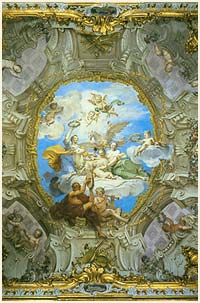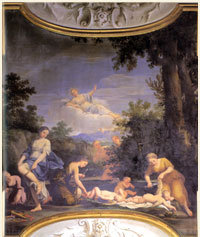By the first half of the eighteenth century, the building was at the centre of a new campaign of interventions on the second state floor.
Based on recent archive discoveries, it is possible to date the arrival of the Pallavicini family on 1711, thus this change of ownership coincides with the renewal of the decorative and iconographic display; Gavazzi in particular puts forward a date for the frescoes at around 1715.
To carry out the work local artists were chosen and painters from the Bologna area, as had become the custom in Genoa.
In the first of the three drawing rooms which look on to Strada Nuova, Giacomo Antonio Boni (Bologna 1688 - Genoa 1766) painted Jupiter and the goat Amaltea: in the central medallion Jupiter, in the form of an eagle and holding a crown, dominates the goat Amaltea, in the imaginative side bays perspectives putti are sitting amongst coloured garlands of flowers.
This was followed by the Genoese artist Domenico Parodi (1670 -1742) who, in the central room, painted Bacchus supporting Ariadne's crown, the main figures being seated on a cloud: around the central frame drunken putti are alternated with those sleeping and those celebrating, and couples, on elegant spirals, hold vases overflowing with grape shoots. The Bacchus theme of the vault reappears again in the medallions .in grisaille' inserted in the squares on the walls.
In the next room the Bolognese artist, Tommaso Aldovrandini, uses the perspectives of the vault and the walls to insert the five famous canvases by Franceschini following the story of Diana.
The decorations by Aldovrandini, dominated by asymmetrical spirals, act as a frame for the symbols of Jupiter and Juno carried out in stucco: in fact on the cornice majestic peacocks alternate with eagles, on the corners appear chains of oak, lily and myrtle branches tied together with ribbons.
The sequence of these three rooms shows the leaning in the new eighteenth century towards a new trend for total decoration, in which two dimensional paintings go together well with three dimensional stucco.
On the side towards the garden two galleries of different lengths run parallel to each other, these are also the result of the eighteenth century interventions: these two spaces, which open out on to the paths, are linked by an exceptional visual and iconographic association with the natural external open spaces, as Magnani explains well. By using stucco and false painted architecture, Domenico Parodi introduces, on the western gallery, a form of decoration which anticipates and accompanies the pergola path which leads to the cave, where Adonis, carved by Parodi himself, is hunting a terrified wild boar. An oval canvas inserted inside the wall decoration, with cherubs flying in a blue sky occupies the centre of the vault of this gallery.
On the other side, in the eastern gallery, Boni painted a perspective looking upwards and a terrace decorated with vases of flowers positioned on a balustrade with foreshortening.
In the centre of the ceiling "Venus's chariot is in the foreground, her doves are flying, the goddess is sleeping with Cupid in her arms, an 'amorino' holds their symbols, the apple and the bow. Juno, Athena, Mars and Jupiter all look on from the sky above; at the entrance a winged cherub invites the watcher to be silent, while others, at the exit towards the garden carry crowns of flowers" (Magnani c.d.s.).
Surrounding this space painted on a wide cornice - of which Gavazza discovered a plan by Paolo Gerolamo Piola - are several dancing putti, and four female figures in stucco, one on each side. Considering the symbols it is possible to recognise in these four figures the personification of the four parts of the world known at that time: America, Asia, Africa and Europe. On the longer sides the symbols of the four elements, two on each side, can be seen: Water, Air, Earth and Fire.

G. A. Boni "Jupiter and the goat Amaltea", vault.

M.Franceschini, "The nymphs of Diana disarming the cherubs".
